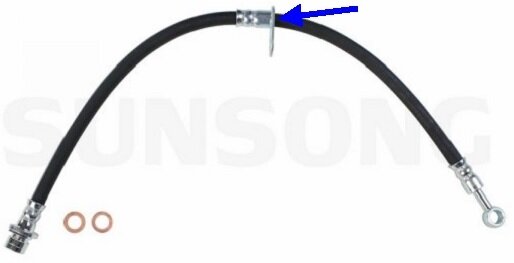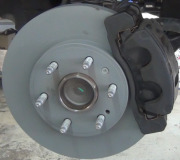New pads won't solve a low brake pedal. Well, actually it might, but not in the way you would think.
I assume you bench-bled the new master cylinder, (and the previous one). Once installed on the vehicle, there will still some air in the lines right where they were unbolted from the master cylinder. Most people then bleed at the wheels to get that air out, but that is not necessary. If you do nothing, and the brake pedal is good enough to drive the car, that air is going to work its way out on its own very quickly When you apply the brakes for a period of time, such as when waiting and waiting and waiting for the red light to turn green, you pushed the air down the lines along with the brake fluid. With the car vibrating, that air will start to float back up. When you release the brake pedal, the fluid rushing back up into the master cylinder will wash the air bubbles along with it, into the reservoir.
Most competent do-it-yourselfers run into more trouble when they try to bleed at the wheels, especially if the vehicle has anti-lock brakes. There are chambers inside the hydraulic controller where that air can become trapped and cause a mushy brake pedal. The only way to expel that air is to activate the solenoids to open the valves to those chambers while a caliper bleeder screw is open. A scanner is needed to perform that function. Once connected, it takes just a few seconds to do both halves of the system, then you finish up by bleeding at the wheels if necessary to get the air out the rest of the way. For trucks that have the older rear-wheel-anti-lock, (RWAL) brakes, no special procedures are needed. The rear circuit is open to fluid flow all the time, so air can pass freely to the rear wheel cylinders.
Let me finish my comment about new brake pads. Back in the '80s it was standard practice to rebuild calipers at every brake job. In later years those calipers don't cause much trouble, so we just slap a new set of pads on. To do that, you have to push the pistons back into the caliper housings to make room for the new, thicker pads. I do that with a flat-blade screwdriver before unbolting the caliper. By pushing the piston in, you push all the brake fluid behind it back up to the reservoir, including any air bubbles that got caught in the lines. You don't actually have to install new pads to push that air out. Just pry the two front pistons in, then run them back out with the brake pedal.
Another note to be aware of. This doesn't apply to your new master cylinder, but when running pistons out of the calipers to adjust them, never push the brake pedal more than halfway to the floor. Over time crud and corrosion build up in the lower halves of the bores in the master cylinder where the pistons don't normally travel. By pushing the brake pedal all the way to the floor, as even some service manuals tell you to do, you run the rubber lip seals over that crud. That can rip them, resulting in a low brake pedal. That commonly takes two or three days to show up. Instead, pretend there's a block of wood under the brake pedal and never push it over halfway to the floor. New or rebuilt master cylinders less than about a year old don't have that buildup yet.
Here's a hint for the next time you need to replace a master cylinder to prevent the need to bleed at the wheels. Loosen the two line nuts at the master cylinder just a little, THEN unbolt it from the power booster. Pay very close attention to the steel lines as you turn the nuts to be sure they're not twisting. If the nuts don't spin freely, the lines will twist and snap off. Then you have another repair to do that involves new fittings and making double flares. Double flares are hard enough for a professional. They're harder to do in the confines of the engine compartment. Pull the master cylinder forward off the mounting bolts, then use it as a handle to bend the two lines upward just enough so those first two inches are not parallel to the ground. Then you can remove the lines. This will prevent the brake fluid from running out of them. Be careful to not drip brake fluid on the car's paint.
After bench bleeding the new master cylinder, leave the reservoir at least half full of fluid. When you install it, you will have to tilt it to line up the ports with the line nuts. Remove one plastic bench-bleeding fitting, then install the steel line nut hand tight. While you do this, fluid will be dripping out, keeping the line and port full. If the nut doesn't thread in easily by hand, it's cross-threaded. Start over and try again until the nut goes in by hand, typically four or five revolutions. If you damage the threads in the aluminum ports, there will be no warranty and you will have to buy another master cylinder.
Once the first line is connected hand tight, do the same thing with the second line. When both fittings are hand tight, bend the master cylinder and lines back down to their normal position, and bolt it to the booster. You'll need a helper for the next step. There will be a little air in the ports and tops of the lines. Tighten the front nut, then loosen the REAR nut about a quarter turn, then have your helper push the brake pedal down very slowly. It should take him about 15 seconds to push it halfway to the floor. Any faster, and the air might still get forced down the lines. While the pedal is moving down, you will see air bubbles coming out around the nut's threads. When the bubbles stop appearing, tighten the nut. Tell your helper to not allow the pedal to move back up until you tell him the nut is tight. Raising the pedal too soon will allow air to be drawn back in through the nut's threads.
When the nut is tight, tell your helper to allow the pedal to come back up QUICKLY. The brake fluid rushing back to the reservoir will wash any air bubbles back too. Do this procedure a second or third time until you don't see any air bubbles, then do the same thing to the front brake line.
As long as the brake pedal is pushed down very slowly, no air will be pushed down the steel lines. The fluid will go down, and the air bubbles will float back up. When the pedal is released quickly, any air bubbles that stick to the lines will be drawn back up to the reservoir.
Fill the reservoir with clean brake fluid from a sealed container to the same level as was found in the old master cylinder. If the level was fairly low, that's what happens when the front brake pads are worn close to the end of their life. Installing new pads results in the fluid returning to the reservoir and the level will go back up to "full". If you fill it before that, the fluid will spill over and make a mess when new pads are installed. That's why we never top off brake fluid during other services such as oil changes. If we see the brake fluid is low, we know to recommend a brake system inspection. The pads are either worn or there's a leak in the system that must be addressed.
Too bad you had to do the job twice, but I'm happy this appears to be the solution.
Wednesday, November 2nd, 2022 AT 6:55 PM





